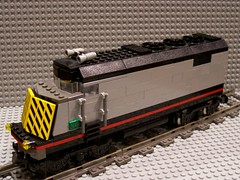Last night at BrickFest, the new 10194 Emerald Night train set was officially announced. For the announcement, they played this video on the big screen…
I shot video of the rest of the announcement and will try to get that edited soon!
Building a brighter tomorrow with LEGO® bricks
Last night at BrickFest, the new 10194 Emerald Night train set was officially announced. For the announcement, they played this video on the big screen…
I shot video of the rest of the announcement and will try to get that edited soon!
I rarely blog about other people’s models, but I wanted to talk a little about the latest work by Anthony Sava (“SavaTheAggie”). It’s the Erie Railroad’s #2602 L-1 Camelback Angus class 0-8-8-0 Steam Locomotive.
This has got to be one of the ugliest pieces of machinery ever built in real life, but the LEGO model is so well done it’s almost beautiful. Well, almost. :-)
But what I wanted to highlight is the way he posted works in progress as a part of the project. People posted comments about the early versions, and he incorporated some of that feedback into the final design, making it feel much more interactive than most LEGO models that are posted online. I think Flickr is particularly good for this, since we can not only post comments on each photo, we can even draw a box on a particular area of a photo and write a comment (a “note”) for that area.
Personally I’ve never posted works in progress (WIP) pictures online. I think partly it makes me feel more pressure to complete the model. There are a lot of LEGO projects that I start but never carry to completion; if they were posted online I wouldn’t feel like I had the luxury of abandoning it if I hit a dead end or lost interest in it. I have worked on a few models collaboratively with others in person but never online. Who knows, maybe I’ll try it. If posting WIP pictures is at all responsible for the quality of this final model, then it’s probably worth a shot.
Oh, and happy new year everybody!
This is my second attempt at modeling a Caltrain diesel locmotive, as seen running commuter trains between San José and San Francisco, CA. Years ago, I built a model of the Caltrain F40PH locomotive. The trickiest part of this engine to model is the nose, which has a “V” shape and also slopes back. In the earlier version, I mounted tiles at a complex compound angle, but was never entirely happy with that. The relatively new 1×1 “cheese” slope piece offers new opportunities for ways to achieve angles like this. But in order to get a smooth slope, I had to use half-plate offsets. I’m pretty happy with the result.
Years ago, I built a model of the Caltrain F40PH locomotive. The trickiest part of this engine to model is the nose, which has a “V” shape and also slopes back. In the earlier version, I mounted tiles at a complex compound angle, but was never entirely happy with that. The relatively new 1×1 “cheese” slope piece offers new opportunities for ways to achieve angles like this. But in order to get a smooth slope, I had to use half-plate offsets. I’m pretty happy with the result.
It is an EMD F40PH, similar to the ones Amtrak used to use for all their long haul trains, used by VIA Rail in Canada, and widely used in commuter lines around the USA and Canada.
This model made its debut at BrickFair, but I couldn’t post about it here since I only finished building it the night before I flew to DC for the convention. I also brought it to this past weekend’s BayLUG meeting in San Leandro.
Other notable features are the windscreens, which are made from 1×2 panels mounted on jumper plates and turned at a slight angle, half-plate inset panels on the sides, and another half-plate offset on the rear door. I’m planning to give a talk on half-plate offsets at BrickCon next month in Seattle. Like the previous version I used 4×4 old style turntables for the roof fans, but in this version there is a Technic gear representing the fan blades. I thought about motorizing them, but haven’t tried it yet.
I keep building stuff and using it in BayLTC displays but not posting them online! Here’s another example. This locomotive was built a few years ago, not long after I first got the Super Chief, which sadly has long been discontinued. Like the Super Chief, the top lifts off and it has a control cab with prime mover motor modeled inside. I also added a head-end unit.
Here’s another example. This locomotive was built a few years ago, not long after I first got the Super Chief, which sadly has long been discontinued. Like the Super Chief, the top lifts off and it has a control cab with prime mover motor modeled inside. I also added a head-end unit.
Key features I’m particularly proud of are the cockpit windows (mounted on plate hinges) and cooling fans (made from 4×4 turntables, taken apart – the base is mounted on the top of the roof, and the top of the turntable is placed underneath to represent intakes). The nose is also mounted at a difficult angle; this is achieved by a combination of hinge elements.
The color scheme is based on the Caltrain commuter trains which run between San Francisco and San Jose, CA. The exterior detailing is minimal, and not terribly accurate (for one thing, the real thing has red and white stripes on the nose, not yellow and black), but at most of our train shows people have immediately recognized it as a Caltrain so I consider it a success.